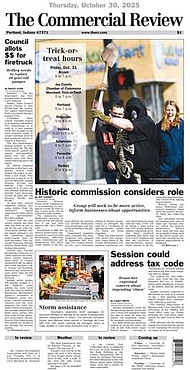July 23, 2014 at 2:10 p.m.
Deadline key in redevelopment (01/13/06)
Portland City Council
By By RACHELLE HAUGHN-
An ordinance setting in motion the establishment of a redevelopment commission will be on the agenda for Monday’s 7 p.m. meeting of the Portland City Council.
City advisers said Thursday that time is of the essence if Portland is to create a tax increment financing (TIF) dristrict which will capture the expected jump in assessment for the Wal-Mart SuperCenter now under construction along West Votaw Street.
“There’s this March 1 date hanging out there,” said Sue Beesley, attorney with Indianapolis law firm Bingham McHale, at a public informational meeting on redevelopment commissions and TIF districts Thursday night.
When Jack Ronald, publisher of The Commercial Review, asked the panel if the driving factor for creating the commission and setting up the districts before March 1 was to capture funds from the new Wal-Mart currently being built, both Beesley and Bruce Hosier, mayor of Portland, answered, “Absolutely.”
Guerrettaz said he recommended to Hosier the deadline be met so funds could be captured from the construction of the discount/grocery store as soon as possible.
“We obviously know (a district is) going to be in the Wal-Mart SuperCenter area,” Beesley said. The size of the district has not yet been decided, she said.
Although the March 1 deadline to establish such a commission in Portland is quickly approaching, advisers on the matter took time Thursday night to answer questions from community members and thoroughly explain how TIF and redevelopment commissions work.
Local residents representing many boards, committees and departments nearly filled a room at the Portland Fire Station to learn the ins and outs of redevelopment commissions and TIF.
The experts told those in attendance that once the ball gets rolling, things will move quickly.
If city council members want to create a redevelopment commission in Portland and capture the TIF money from current developments such as the Wal-Mart SuperCenter, they must pass an ordinance by March, she said. Also before the deadline, the new commission must decide where the TIF district or districts will be located and how the TIF funds will be used.
If the council votes to create a commission, and the new commission decides where the TIF districts will be located, the assessed value of properties in each district will be frozen. If the deadline is met, the value will be tallied between March 1, 2005, and March 1 of this year.
If the deadline is not met, the assessed value will have to fall between March 1 and March 1, 2007, or later, Beesley said.
After the first assessed value is determined, the value of the properties in the district is again assessed a year later. The difference between the two values is then multiplied by the current tax rate. This amount can be used for improvements within the district, said Greg Guerrettaz, certified public accountant with Financial Solutions Group, Inc.
Guerrettaz said this morning, he, Beesley, Hosier, Kristi Sturtz, principal planner and owner of Sturtz Public Management Group; city attorney Bill Hinkle and Bob Quadrozzi, executive director of Jay County Development Corporation; are coming up with ideas for where TIF districts could be located in the city. These ideas for possible districts would be recommended to the redevelopment commission, he said.
Hosier said if a district is established in the area surrounding Wal-Mart, the amount of TIF funds the project could generate “will be a considerable amount of money.”
Bryan Alexander, a member of the Jay School Board, asked the panel how the commission would determine where to create districts.
Beesley said TIF districts are established where a new business is being built or is expected to be constructed. The funds generated are used to make improvements within the district on buildings, sidewalks, streets, etc.
TIF funds also could be used to make improvements in downtown Portland, said Sturtz. She recently was hired by the city to help with the establishment of TIF districts.
Sturtz said the commission could obtain permission from owners of downtown buildings to improve the appearance of store fronts. TIF funds also could be used as local matches for grants, she said.
TIF districts typically last from 10 to 30 years, Sturtz said.
Creating TIF districts can also be a good way to attract developers, said Bob Quadrozzi, executive director of Jay County Development Corporation.
Quadrozzi said the idea of TIF was first introduced in Indiana in 1975, with the first district established in the late 1970s or early ’80s.
Before taking his current job in Jay County, Quadrozzi worked for the city of Battle Creek, Mich. Quadrozzi said the city had about four TIF districts. In the city’s industrial park, which was a TIF district, 62 industries located there in six years.
After the meeting, Beesley said industries are attracted to TIF districts because the basic infrastructure — such as access to streets and utilities — is already in place thanks to TIF funds.
Other counties which have redevelopment commissions and TIF districts include Delaware, Blackford, Grant and Henry counties, Quadrozzi said.
When Wal-Mart and Dollar General were trying to decide where to locate new distribution centers, the companies considered Portland, he said.
“We were out right away because we had no TIF,” Quadrozzi said.
Although there are negatives to not having TIF districts, there can also be downsides to establishing such districts.
Tom Kennedy, a member of the Portland Planning Commission, asked what the potential negative side to creating a TIF district could be.
Beesley said sometimes cities make improvements in districts, expecting TIF funds to be available, and later discover there is not enough money to cover the cost of the work. One city had to refinance to cover its debt, she said.
Guerrettaz said in order to prevent such a problem, commissions should have a backup plan in place.
Beesley said if a commission is established in Portland, economic development income tax funds or property tax funds could be used as backup funds.[[In-content Ad]]
City advisers said Thursday that time is of the essence if Portland is to create a tax increment financing (TIF) dristrict which will capture the expected jump in assessment for the Wal-Mart SuperCenter now under construction along West Votaw Street.
“There’s this March 1 date hanging out there,” said Sue Beesley, attorney with Indianapolis law firm Bingham McHale, at a public informational meeting on redevelopment commissions and TIF districts Thursday night.
When Jack Ronald, publisher of The Commercial Review, asked the panel if the driving factor for creating the commission and setting up the districts before March 1 was to capture funds from the new Wal-Mart currently being built, both Beesley and Bruce Hosier, mayor of Portland, answered, “Absolutely.”
Guerrettaz said he recommended to Hosier the deadline be met so funds could be captured from the construction of the discount/grocery store as soon as possible.
“We obviously know (a district is) going to be in the Wal-Mart SuperCenter area,” Beesley said. The size of the district has not yet been decided, she said.
Although the March 1 deadline to establish such a commission in Portland is quickly approaching, advisers on the matter took time Thursday night to answer questions from community members and thoroughly explain how TIF and redevelopment commissions work.
Local residents representing many boards, committees and departments nearly filled a room at the Portland Fire Station to learn the ins and outs of redevelopment commissions and TIF.
The experts told those in attendance that once the ball gets rolling, things will move quickly.
If city council members want to create a redevelopment commission in Portland and capture the TIF money from current developments such as the Wal-Mart SuperCenter, they must pass an ordinance by March, she said. Also before the deadline, the new commission must decide where the TIF district or districts will be located and how the TIF funds will be used.
If the council votes to create a commission, and the new commission decides where the TIF districts will be located, the assessed value of properties in each district will be frozen. If the deadline is met, the value will be tallied between March 1, 2005, and March 1 of this year.
If the deadline is not met, the assessed value will have to fall between March 1 and March 1, 2007, or later, Beesley said.
After the first assessed value is determined, the value of the properties in the district is again assessed a year later. The difference between the two values is then multiplied by the current tax rate. This amount can be used for improvements within the district, said Greg Guerrettaz, certified public accountant with Financial Solutions Group, Inc.
Guerrettaz said this morning, he, Beesley, Hosier, Kristi Sturtz, principal planner and owner of Sturtz Public Management Group; city attorney Bill Hinkle and Bob Quadrozzi, executive director of Jay County Development Corporation; are coming up with ideas for where TIF districts could be located in the city. These ideas for possible districts would be recommended to the redevelopment commission, he said.
Hosier said if a district is established in the area surrounding Wal-Mart, the amount of TIF funds the project could generate “will be a considerable amount of money.”
Bryan Alexander, a member of the Jay School Board, asked the panel how the commission would determine where to create districts.
Beesley said TIF districts are established where a new business is being built or is expected to be constructed. The funds generated are used to make improvements within the district on buildings, sidewalks, streets, etc.
TIF funds also could be used to make improvements in downtown Portland, said Sturtz. She recently was hired by the city to help with the establishment of TIF districts.
Sturtz said the commission could obtain permission from owners of downtown buildings to improve the appearance of store fronts. TIF funds also could be used as local matches for grants, she said.
TIF districts typically last from 10 to 30 years, Sturtz said.
Creating TIF districts can also be a good way to attract developers, said Bob Quadrozzi, executive director of Jay County Development Corporation.
Quadrozzi said the idea of TIF was first introduced in Indiana in 1975, with the first district established in the late 1970s or early ’80s.
Before taking his current job in Jay County, Quadrozzi worked for the city of Battle Creek, Mich. Quadrozzi said the city had about four TIF districts. In the city’s industrial park, which was a TIF district, 62 industries located there in six years.
After the meeting, Beesley said industries are attracted to TIF districts because the basic infrastructure — such as access to streets and utilities — is already in place thanks to TIF funds.
Other counties which have redevelopment commissions and TIF districts include Delaware, Blackford, Grant and Henry counties, Quadrozzi said.
When Wal-Mart and Dollar General were trying to decide where to locate new distribution centers, the companies considered Portland, he said.
“We were out right away because we had no TIF,” Quadrozzi said.
Although there are negatives to not having TIF districts, there can also be downsides to establishing such districts.
Tom Kennedy, a member of the Portland Planning Commission, asked what the potential negative side to creating a TIF district could be.
Beesley said sometimes cities make improvements in districts, expecting TIF funds to be available, and later discover there is not enough money to cover the cost of the work. One city had to refinance to cover its debt, she said.
Guerrettaz said in order to prevent such a problem, commissions should have a backup plan in place.
Beesley said if a commission is established in Portland, economic development income tax funds or property tax funds could be used as backup funds.[[In-content Ad]]
Top Stories
9/11 NEVER FORGET Mobile Exhibit
Chartwells marketing
September 17, 2024 7:36 a.m.
Events
250 X 250 AD

